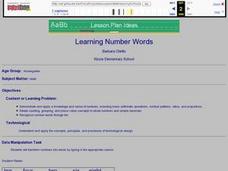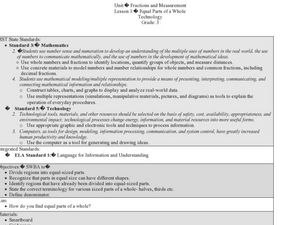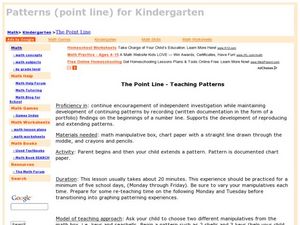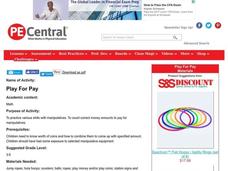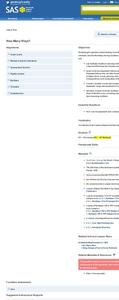Curated OER
Learning Number Words
Students practice saying their numbers and identifying the words. They use whole numbers and decimals to practice grouping numbers into different categories. They write the word of the number they are shown.
Curated OER
Writing Variable Expressions for Physical Models
Explore the concept of writing variable expressions by examining the similarities between expressions with numbers and expressions with variables. Emerging mathematicians determine rules for sequences and patterns before writing a rule...
Curated OER
Finding Volume of Similar Figures
Upper elementary and middle schoolers examine the Volumes of Similar Figures. They investigate the relationship between corresponding sides and evaluate the volume of similar figures. Pupils record their findings on various activity...
Curated OER
Fractions and Measurement
Using a Smart Board, or a plain ol' white board or chalkboard, the teacher pulls up a grid and demonstrates how squares and rectangles can be divided up into equal parts. The class will get their own graph paper to draw shapes and divide...
California Academy of Science
Optimal and Sustainable: Renewable Energy Revamp
More than 100 cities around the world have shifted from fossil fuels to renewable energy sources. Scholars investigate a city wanting to make this switch, but needs help determining how to make the shift. Groups consider all options,...
Curated OER
Addition Stories
First graders incorporate language expressions, such as first, then, and together into a story and write the math equations that they represent. Concepts for the process of addition are developed using manipulatives, modeling, and...
Curated OER
The Point Line - Teaching Patterns
Students practice extending patterns. In this patterns lesson, students demonstrate extending patterns by performing a rhythmic patter.
Curated OER
Play For Pay
Young scholars practice various skills with manipulatives, such as counting correct money amounts to pay for manipulatives.
Curated OER
Angle Attributes and Measures
Seventh graders explore the concept of angles. In this angles lesson, 7th graders use protractors to measure angles. Students sing an angle song. Students discuss attributes of angles using a two-color plate manipulative.
Curated OER
PASS the Arts
Learners explore math and art concepts, create digital art examples of the concepts, and incorporate these works into a PowerPoint portfolio with explanation and analysis.
Curated OER
the Squares of Numbers in Multiplication
Students memorize the multiplication math facts and learn many different ways of visualizing and practicing the multiplication concepts. They begin practicing with arrays, skip counting, and moving manipulatives for the 0, 1, 2, 3, and 4.
Curated OER
Tourism in London
Students discuss the tourist attractions that are in London. They examine how data can be manipulated by completing a worksheet. They plan a trip to a London attraction after conducting Internet research.
Curated OER
How Many Ways?
Second graders develop number sense. In this number sense lesson, 2nd graders use multiple ways to represent numbers including written numerals, tally marks and manipulatives. Students correctly use place value to the thousands place.
Curated OER
TE Activity: Tears in Rain
Pupils examine photographs before writing captions for them. They develop visual literacy as they see how photographs are manipulated to show the effects of acid rain. They rewrite the photo captions after a class discussion.
Curated OER
Equivalent forms of Fractions
Fourth graders use kidspiration software to demonstrate understanding of the concept of equivalent fractions. Using a combination of manipulatives, computer software and writing teachers can easily assess student mastery of number sense.
Curated OER
Subtraction with Calculators
First graders demonstrate an understanding of subtracting one from a number of ten or less using manipulatives, work with calculators to solve subtraction problems, and create subtraction number sentences to solve on the calculator.
Curated OER
What Does Average Look Like?
Fifth graders, in groups, study the concepts of range, median, mode, and mean through the use of graphs drawn from models. They use manipulatives to represent data that they have collected within groups.
Curated OER
Basic Geometry Ideas and Angle Measurement
Seventh graders explore the concept of basic geometry. For this basic geometry lesson, 7th graders identify the correct picture for a given vocabulary word such as midpoint, line, ray, or parallel lines. Students discuss examples of...
Alabama Learning Exchange
Explore the Transformations of Linear and Absolute Value Functions Using Graphing Utilities
Learners explore the concept of transformations. For this transformation lesson plan, students use an applet that is an interactive absolute value graph applet. Learners manipulate the applet to examine the change in the function and...
Curated OER
Basic Equivalencies
First graders manipulate coins to show equivalencies between pennies and dimes. Given specific values, 1st graders model the specified amounts by using pennies and dimes. Through use of a computer assisted trading coins, students...
Pennsylvania Department of Education
Tangram Challenges
Students explore geometric concepts by working with Tangram Puzzles. In this Tangram challenge lesson plan, students use problem-solving tasks that involve physical manipulatives. Students select a picture and use all seven pieces of the...
Curated OER
M & M Fractions
Students explore the concept of fractions using M & M candies as a manipulative. They sort the candies, and write the correct fraction for each color of M & M's.
Curated OER
Story Problems
First graders manipulate pictures in Powerpoint template to demonstrate understanding of story problems. Students then solve story problems, and write number sentence to correspond to each story problem.
Curated OER
Geometric Shapes at the OK Corral
Students explore regular geometric shapes. In this shapes lesson, students investigate geometric shapes in the world around them. Students differentiate between regular and irregular shapes.


